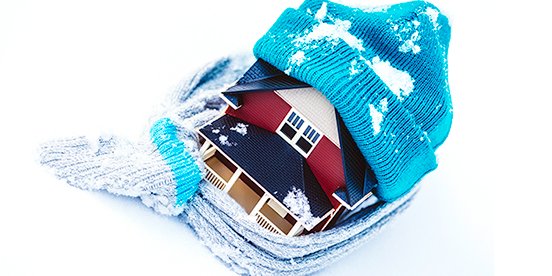The winter months can do a number on your home’s heating bill. As you crank up your furnace to keep yourself comfy and cozy, snow and ice builds up around your house and the chill tries to sneak inside. It’s a constant battle, fought by insulation, weather stripping, and double-glazed windows, as you try to keep the heat in and the cold out.
That’s a good way to frame the conversation when you’re looking at ways of winterizing your home. If you can keep the heat in, the cold out, and make your heating as efficient as possible, then you’re really winning the winterizing game.
If you’re looking for tips to make this happen, you’re in the right place. Let’s get started with efficiency.
Make your heating as efficient as possible
1. Change your furnace filter
The mechanics of a furnace are relatively simple:
- Heat the air
- Blow the hot air around your house
Your furnace filter removes dust, hair, and other particulates from the air before it enters the combustion chamber. That way, your burners aren’t torching all of the dust that floats around your house. It ensures a cleaner burn, which is better for your burners and helps to eliminate any smells.
But, if you don’t change your filter regularly, your furnace’s blower (the mechanism that facilitates air flow) will have to work harder, and that’s not efficient.
Change your furnace filter every couple of months, or, if you have pets, every month. That ensures you’re getting good airflow through the system and that you’re maximizing the amount of warm air moving through your home.
2. Reverse your ceiling fans
Hot air rises, but you and your family probably spend most of your time on the floor. Your house fans can perform a very useful service for you in the winter by blowing the hot air trapped near the ceiling back down to ground level. All you have to do is reverse their direction.
While ceiling fans are designed to push air downward creating a cool draft for those beneath, their direction can be reversed so that they instead draw the cool air upwards and force the hot air near the ceiling back down into the room.
All ceiling fans have a switch located somewhere on them to facilitate this change in direction, just make sure you switch them back in the summer when things start to heat up!
4. Get a programmable or a smart thermostat
An efficient house will be warm when it’s needed and cool down when it’s not. Whether you want to manually program these changes or let an AI figure them out, is up to you.
If you and your family keep a consistent schedule, and you don’t mind spending a little time figuring out what that schedule is, you can use your programmable thermostat to lower the temperature while you’re away and raise it while your home. Lowering the temperature at night, while everyone is asleep, and turning it up in the morning is also a good way to save on the heating bill.
If you like the tech, you can invest in a smart thermostat, which will learn from your schedule as you use it. All you need to do is adjust the temperature to how you like it over the course of a week, and the smart thermostat will take it from there, creating a schedule based off your habits.
Keep the cold out and the heat in
1. Replace weather stripping
Your doors and windows are the first place to look when identifying places where the cold could be sneaking inside. If your weather stripping hasn’t been replaced in a few years, it could be ripped or frayed, creating gaps where drafts and chills can seep into your house.
Grab some replacements from your local hardware store and make sure all of these locations are sealed up tight.
2. Hang some curtains
Heavy curtains can add a little extra insulation to your windows, allowing you to keep the chill out. This is especially true for large windows.
Quilted drapes or thick blinds can add an extra layer of warmth to a room, keeping the cold out and the room feeling cozy.
3. Let the sun in
When the sun is shining, make sure to open your drapes and curtains to allow the rays inside. This form of passive heating is vital in a lot of homes that shoot for a Net Zero rating, as it allows for significant warmth to enter your home at zero cost to the home owner.
4. Add insulation to your attic
If it hasn’t already been done, add some insulation to your attic. Proper insulation in this upper area of your house can make big changes for your homes efficiency. Insulation laid flat along your attic floor will keep hot air from the rooms below from leaking into the attic and away from the people that need it.
